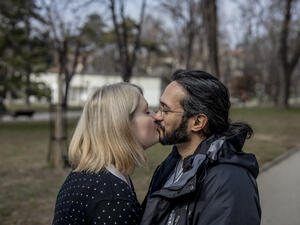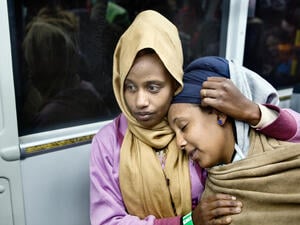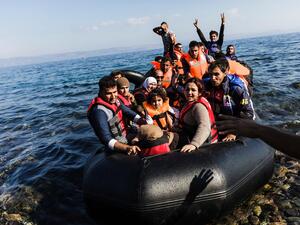Refugee show lights up Serbian screens for 10 years
Refugee show lights up Serbian screens for 10 years

A UNHCR-funded TV crew films a displaced Roma family from Kosovo receiving materials to build a new house near Zajecar in eastern Serbia.
BELGRADE, Serbia, September 30 (UNHCR) - A decade is an eternity in television, especially for a programme targeting a niche audience - refugees in Serbia. But as the UNHCR-produced show, "A Time to Decide", entered its 10th year recently, it found itself with over a million viewers, not just in Serbia but also in the greater Balkans region.
The weekly programme was conceptualized several years after the 1991-1995 wars in Croatia and Bosnia and Herzegovina, which resulted in one of Europe's biggest refugee crises since World War II. Recognizing the reconciliatory role of mass media in the post-conflict western Balkans, UNHCR decided to use TV to fill the information gap in the national media and raise awareness about the hardships faced by the displaced people.
The refugee agency worked with Belgrade-based Yes-Pro Media Company to coordinate filming in Serbia, Kosovo, Croatia, Bosnia and Herzegovina in order to provide refugees with reliable information about their home and host countries. UNHCR also brokered an agreement with Serbian public service television, RTS, to provide 30 minutes of free air time every week.
The first episode of the programme, initially titled "The New Bridges", was broadcast in August 2001. This was where refugees in Serbia saw the first images of their villages in Croatia and in Bosnia and Herzegovina since the dissolution of Yugoslavia. It was also where they heard the presidents of neighbouring countries inviting refugees to come back - many years before relations between countries in the region improved.
Over the years, the refugees have continued to tune in for information on return prospects and assistance for repatriation, integration and legal counselling. Regular features include returnee stories, statements by local or state officials and representatives of international stakeholders. It was important to get the decision-makers and returnees themselves to tell their stories on screen, adding credibility to the show and proving that return was possible.
"I watched your programme regularly and it was thanks to the information and the images I saw there that I made my mind to come back here," Simo Gutesa, a returnee in a village near Gospic in Croatia, told a visiting TV crew recently. "I only regret I hadn't returned earlier."
Encouraged by the increased interest in repatriation, UNHCR Serbia in 2003 started another TV programme, "Return," aimed at internally displaced people from Kosovo living in Serbia.
That same year, when various integration options became available in Serbia with support from the European Union, the title of the refugee TV programme was changed to "A Time to Decide" to reflect the choices refugees have to make.
Both programmes became very popular soon after their launch, not only among refugees and displaced persons, but also among the general public. With ratings of over 500,000 viewers on several occasions, they were among the top 10 programmes in Serbia.
Currently, the weekly shows are watched by nearly 1 million viewers in Serbia. Many more - including returnees and others in neighbouring countries - watch them via satellite.
According to government sources, Serbia hosts about 74,000 refugees from Croatia and Bosnia and Herzegovina, and about 210,000 internally displaced people from Kosovo, with almost 100,000 still in need of assistance. Since repatriation began in 1996, more than 73,000 refugees have repatriated to their original countries, while only 13,500 displaced people have returned to Kosovo since 2000.
By Vesna Petkovic in Belgrade, Serbia









